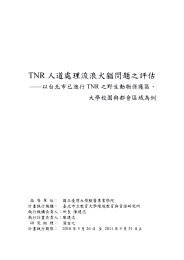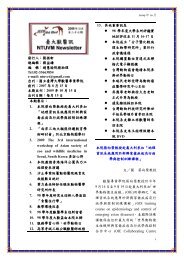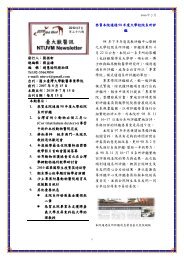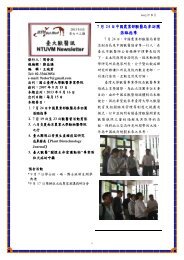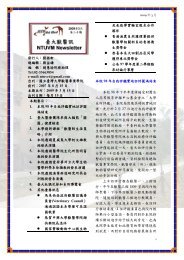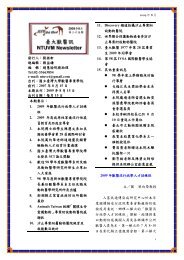Refractory Pulmonary Edema
Treatment of Refractory Cardiogenic Pulmonary Edema
Treatment of Refractory Cardiogenic Pulmonary Edema
You also want an ePaper? Increase the reach of your titles
YUMPU automatically turns print PDFs into web optimized ePapers that Google loves.
<strong>Refractory</strong> <strong>Pulmonary</strong> <strong>Edema</strong><br />
洪 榮 偉<br />
Yong-Wei Joey Hung, DVM, MS<br />
中 華 民 國 獸 醫 內 科 醫 學 會<br />
Taiwan Academy of Veterinary Internal Medicine<br />
Cardiospecial Veterinary Hospital<br />
November 14 2010
Drs. Dennis Chew and<br />
Stephen DiBartola<br />
2011/11/5,6<br />
Non-obstructive idiopathic/interstitial<br />
cystitis in cats: Thinking outside the<br />
(litter) box<br />
Urinary incontinence in dogs –<br />
diagnosis and treatment<br />
Prolonging life and kidney function<br />
……………………………………
cardiogenic vs non-<br />
cardiogenic
Normal alveolus
Classification of pulmonary edema based<br />
on mechanism and imbalance of starling<br />
forces<br />
J = K f ([P c - P i ] - σ [π c - π i ])
Classification of pulmonary edema based<br />
on mechanism and imbalance of starling<br />
forces<br />
Increased Capillary Wedge Pressure<br />
Left heart failure<br />
Increased pulmonary<br />
arterial pressure (so called<br />
over perfusion pulmonary<br />
edema) –e.g. PDA Increased<br />
pulmonary capillary pressures
Classification of pulmonary edema based<br />
on mechanism and imbalance of starling<br />
forces<br />
Decreased Osmotic Pressure<br />
Unlikely sole cause but can contribute
Classification of pulmonary edema based<br />
on mechanism and imbalance of starling<br />
forces<br />
Increased negativity of interstitial pressure<br />
(re-expansion edema)<br />
Rapid removal of pneumothorax or pleural<br />
effusion with large applied negative pressures<br />
Large negative pressures due to airway<br />
obstruction
Classification of pulmonary edema based<br />
on mechanism and imbalance of starling<br />
forces<br />
Impaired Lymphatic drainage –<br />
Lymphatic removes edema from the<br />
interstitium.<br />
With chronic elevations in left atrial<br />
With chronic elevations in left atrial<br />
pressure (chronic MR)- pulmonary<br />
lymphatic systems hypertrophies
Classification of pulmonary edema based<br />
on mechanism and imbalance of starling<br />
forces<br />
Alveolar-Capillary Barrier Damage→ ARDS<br />
defined as<br />
1. acute onset<br />
2.normal PCWP < 18<br />
3.diffuse bilateral pulmonary edema<br />
4. PaO2: FiO2
Classification of pulmonary edema based<br />
on mechanism and imbalance of starling<br />
forces<br />
ARDS<br />
Risk factors are categorized by direct or<br />
indirect lung injury.
Classification of pulmonary edema based<br />
on mechanism and imbalance of starling<br />
forces<br />
Direct lung injury –<br />
Aspiration of gastric contents,<br />
blunt trauma (pulmonary contusions),<br />
near-drowning,<br />
inhalation of noxious gases,<br />
oxygen toxicity,<br />
pneumonia,<br />
radiation pneumonitis
Classification of pulmonary edema based<br />
on mechanism and imbalance of starling<br />
forces<br />
Indirect (secondary) lung injury –<br />
SIRS,<br />
Trauma,<br />
parvovirus,<br />
sepsis,<br />
pancreatitis,<br />
organ torsion,<br />
multiple transfusion,<br />
hypersensitivity reaction,<br />
Snake bite
Incompletely understood<br />
pulmonary edema syndromes<br />
High altitude pulmonary edema –<br />
abnormal rise in PA pressure and PVR in<br />
response to hypoxia.<br />
Typically occurs when rapidly ascend to<br />
Typically occurs when rapidly ascend to<br />
altitude in excess of 2500 meters.
Incompletely understood<br />
pulmonary edema syndromes<br />
Neurogenic pulmonary edema –<br />
a variety of CNS disorders can be associated<br />
with pulmonary edema.<br />
Massive catecholamine surges
Incompletely understood<br />
pulmonary edema syndromes<br />
After electric shock (electric bite cord injury<br />
or cardioversion) – similar mechanisms<br />
proposed as in neurogenic edema
Treatment of <strong>Refractory</strong> Cardiogenic<br />
<strong>Pulmonary</strong> <strong>Edema</strong><br />
Heart rate<br />
Digoxin<br />
Beta Blockers<br />
Ca ++ Ch. Blockers<br />
Antiarrhythmics<br />
Cardiac<br />
Output<br />
Preload<br />
Diuretics<br />
Venodilators<br />
Mixed Vasodilators<br />
NaCl restriction<br />
Contractility<br />
Digoxin<br />
Catacholamines<br />
Phosphodiesterase inhibitors<br />
Pimobendam<br />
(Beta Blockers)<br />
Afterload<br />
Arterial Vasodilator<br />
Mixed Vasodilator
Treatment of <strong>Refractory</strong><br />
Cardiogenic <strong>Pulmonary</strong> <strong>Edema</strong><br />
Be sure of your diagnosis. Ddx: respiratory<br />
disease, ARDS. If edema is coughed up<br />
measure the edema fluid/serum protein ratio.<br />
(< 0.5 = cardiogenic, > 0.7 = non<br />
cardiogenic edema).
Treatment of <strong>Refractory</strong><br />
Cardiogenic <strong>Pulmonary</strong> <strong>Edema</strong><br />
Physical exam<br />
Cardiogenic pulmonary edema<br />
auscultation of an S 3<br />
gallop<br />
a murmur consistent with valvular stenosis or regurgitation<br />
elevated neck veins, an enlarged and tender liver, and peripheral<br />
edema<br />
cool extremities<br />
Noncardiogenic pulmonary edema<br />
abdominal, pelvic, and rectal examinations are important<br />
warm extremities
Treatment of <strong>Refractory</strong><br />
Cardiogenic <strong>Pulmonary</strong> <strong>Edema</strong><br />
Laboratory TEST<br />
BNP is secreted predominantly by the cardiac atria and<br />
ventricles in response to wall stretch or increased<br />
intracardiac pressures<br />
Released as precursor molecules then cleaved by serum<br />
protease to form equal amount of active C-BNP and<br />
inactive NT-proBNP<br />
In dogs: (2010 ACVIM Ettinger, et al)<br />
Entry level NTproBNP values >1800 pmol/L in dogs or<br />
>270 pmol/L in cats are a good prognostic indicator of<br />
severe heart disease (HF)<br />
Treatment of <strong>Refractory</strong><br />
Cardiogenic <strong>Pulmonary</strong> <strong>Edema</strong><br />
Laboratory TEST<br />
BNP can also be secreted by the right ventricle,<br />
and moderate elevations have been reported in<br />
patients with acute pulmonary embolism, cor<br />
pulmonale, and pulmonary hypertension<br />
NT-proBNP is mainly eliminated by kidneys. The<br />
measurements will be unreliable if renal function is<br />
impaired.
Treatment of <strong>Refractory</strong><br />
Cardiogenic <strong>Pulmonary</strong> <strong>Edema</strong><br />
Stop high salt IV fluids (e.g., LRS).<br />
Usually not salt or volume deficient<br />
Use 5% Dextrose in water or another low<br />
salt fluid.<br />
May be hyponatremic, total body sodium<br />
content is high.
Treatment of <strong>Refractory</strong> Cardiogenic<br />
<strong>Pulmonary</strong> <strong>Edema</strong><br />
Furosemide CRI after an initial bolus has<br />
a greater diuretic effect than the same dose<br />
given as a bolus.<br />
2 – 4 mg/kg IV or IM q 2- 12 hrs PRN<br />
Not to exceed 12 mg/kg/day.<br />
CRI 0.25 – 0.5 mg/kg/hr over 4-8 hrs after<br />
initial bolus.<br />
(Adin et al, J Vet Intern Med 2003)
Treatment of <strong>Refractory</strong> Cardiogenic<br />
<strong>Pulmonary</strong> <strong>Edema</strong><br />
Nitroglycerin 2 % paste:<br />
¼ inch for small dogs/cats up to 1 inch for<br />
large dogs transdermal (inner ear pinnae,<br />
groin or axilla) PRN first 24 hours.<br />
(Paraneswarab et al, J Vet Intern Med 1999)
Treatment of <strong>Refractory</strong> Cardiogenic<br />
<strong>Pulmonary</strong> <strong>Edema</strong><br />
Sedation<br />
ease the anxiety associated with<br />
breathlessness and should decreased the<br />
work of breathing.<br />
Using sedatives with a vasodilatory effect<br />
such as morphine or acepromazine
Treatment of <strong>Refractory</strong> Cardiogenic<br />
<strong>Pulmonary</strong> <strong>Edema</strong><br />
Oxygen supplementation (40%)<br />
reduce the work of breathing.
Treatment of <strong>Refractory</strong> Cardiogenic<br />
<strong>Pulmonary</strong> <strong>Edema</strong><br />
Cage rest and minimal stress are crucial.
Treatment of <strong>Refractory</strong> Cardiogenic<br />
<strong>Pulmonary</strong> <strong>Edema</strong><br />
Ensure maximize ACE-inhibition.<br />
Enalapril can lower pulmonary capillary<br />
wedge pressure acutely. (IMPROVE, J Vet<br />
Intern Med, 1995)<br />
maximize dose to 0.5 mg/kg BID .<br />
creatinine < 3.0 mg/dl, give ACEI unless<br />
severely hypotensive or azotemic.
OK – so I’ve done all the above and<br />
they’re still dyspneic. Let’s “kick it up a<br />
notch”
Be sure of your diagnosis and better<br />
characterize the heart disease<br />
quick (“sneak and peak”) echocardiogram<br />
BIG left atrium,<br />
assess valve anatomy (ruptured chordae tendonae,<br />
vegetative endocarditis),<br />
masses.<br />
You may also see a heart that<br />
doesn’t support your diagnosis<br />
of cardiogenic pulmonary edema.
Sodium Nitroprusside<br />
Sodium Nitroprusside<br />
Potent balanced vasodilator given as a CRI.<br />
MAP of approximately 70-75 mmHg.<br />
Direct arterial blood pressure should be<br />
monitored.<br />
Only used in the first 24-48 hours of acute<br />
therapy. (Yoran, Am J Cardiol, 1979)
Additional vasodilators – Amlodipine<br />
or hydralazine<br />
hydralazine or amlodipine<br />
Start low and titrate upwards<br />
Hydralazine has a quicker onset of action than<br />
amlodipine and can be given IV.<br />
Amlodipine is only available as an oral<br />
medication and it can be pricey in a large<br />
breed dog
Additional diuretics – Aldactazide<br />
or Spironolactone<br />
By using a diuretic with a different site of<br />
action (sequential nephron blockade), the<br />
diuretics will have a synergistic diuretic<br />
effect.<br />
Aldactazide is a combination of<br />
spironolactone and hydrochlorthiazide and<br />
can be very potent.<br />
Adverse effects include azotemia and<br />
electrolyte disturbances.
Optimize heart rate and rhythm<br />
Ventricular tachycardia (lidocaine +/- sotolol in dogs)<br />
In dogs, with rapid Afib and cardiogenic shock,<br />
Digoxin 0.001 mg/kg IV q 1 hour for 2-4 hours after<br />
dobutamine.<br />
If not in cardiogenic shock,<br />
IV diltiazem to slow ventricular response rate to < 200<br />
/min in hospital.<br />
For a cat with severe hypertrophic cardiomyopathy and<br />
rapid ventricular tachycardia,<br />
Beta blockers.<br />
Sick sinus syndrome or third degree AV block<br />
pacemaker
What is your treatment?
If biventricular heart failure, tap<br />
pleural effusion and/or ascites<br />
Removal of the fluid, in addition to diuretic<br />
therapy.<br />
Therapeutic thoracocentesis.<br />
Increase the functional reserve capacity and<br />
Increase the functional reserve capacity and<br />
tidal volume of the lungs and improve<br />
oxygenation.
Positive Inotropes: Pimobendan<br />
or Dobutamine<br />
Pimobendam<br />
canine dilated cardiomyoapthy, chronic valvular<br />
heart disease and cats with remodeled hypertrophic<br />
cardiomyopathy or dilated cardiomyopathy.<br />
Increased contractility and vasodilation, i.e.,<br />
inodilator.<br />
The most common adverse effect is<br />
tachyarrhythmias.<br />
Dobutamine is an intravenous beta agonist<br />
(primarily beta 1) that increases contractility and<br />
potentially heart rate.
Empiric use of bronchodilator in small<br />
breed dog with possible concurrent<br />
airway disease<br />
Bronchodilators assist in dyspnea by its actions on<br />
bronchodilation and strengthening muscles of<br />
respirations.<br />
Many small breed dogs with advanced valvular<br />
heart disease may also have significant airway<br />
disease.<br />
Inhaled brochodilation in cats with possible<br />
concurrent asthma.<br />
Tachyarrhythmias.
Correct concurrent diseases such as<br />
anemia or arterial-venous shunt<br />
Chronic anemia and an AV fistula/shunt<br />
(PDA or other)<br />
High cardiac output and potential congestive<br />
heart failure
Ventilator therapy<br />
Ventilation essentially supports their respiratory<br />
function while allowing their left atrium time to<br />
stretch (if ruptured chordae tendonae) and time for<br />
the medications to improve their cardiovascular<br />
function.<br />
Ventilation also allows one to perform further<br />
diagnostics (chest rads, tracheal wash, Swan Ganz<br />
catheter )under safe environment if the cause of the<br />
dyspnea is in doubt.<br />
A typical heart failure ventilator case is usually<br />
better (or not) within 1-3 days of therapy.
Thanks for your attention






